Are you looking to maximize the conversion potential of your website’s landing pages?
Wondering how to optimize landing pages for conversion and boost your results?
Welcome to this ultimate guide on landing page optimization, where we’ll explore the strategies, tips, and best practices to create highly optimized landing pages that drive impressive conversion rates.
But first, let’s address the fundamental question: What is landing page optimization and why is it essential for your online success?
Landing page optimization is the process of refining and improving various elements of a landing page to increase its conversion rate.
A landing page serves as a standalone destination where visitors “land” after clicking on a specific call-to-action, such as an advertisement or a search result.
Its primary objective is to compel visitors to take a desired action, be it making a purchase, signing up for a newsletter, or filling out a contact form.
Now, you might wonder, “Why should I invest time and effort into optimizing my landing pages?”, right?
The answer lies in the potential gains that effective landing page optimization brings.
According to a study, companies that have 10 to 15 landing pages witness a staggering 55-60% increase in leads compared to those with fewer landing pages.
This indicates the significant impact that landing page optimization can have on your lead generation efforts.
Moreover, landing pages are widely regarded as one of the most effective lead-generation tactics, particularly for B2B companies.

Landing page optimization is a crucial component of any successful digital marketing strategy.
By applying the right landing page optimization tips, following proven best practices, and incorporating landing page optimization keywords, you can create landing pages that not only attract your target audience but also engage and drive them to take the desired actions.
In this guide, we’ll provide you with an in-depth understanding of landing page optimization and equip you with practical techniques to implement.
From developing compelling headlines and crafting persuasive copy to designing intuitive layouts and incorporating trust signals, we’ll cover every aspect.
Additionally, we’ll provide you with a comprehensive landing page optimization checklist, tips, and examples that you can apply to your campaigns.
Whether you’re a seasoned marketer seeking to refine your landing page optimization skills or a beginner eager to learn the ropes, this guide has been carefully curated to meet your needs.
Let’s check out together and unlock the full potential of your landing pages!
Understanding Landing Page Optimization
What is a Landing Page?
When it comes to online marketing and lead generation, a landing page plays a crucial role.
But what exactly is a landing page?
A landing page is a stand-alone web page created to attract visitors and encourage them to take some sort of action.
It is the page that visitors arrive at after clicking on an advertising, search result, or promotional link, and so acts as the “landing” page for your website.
Landing pages are distinct from the rest of your site since they are designed to convert visitors into customers.
It might be anything from buying something to joining up for a newsletter to downloading an ebook to trying out a new service for free.
Conversion rates can be increased by using a landing page because of its laser-like concentration and lack of extraneous information.
Key Goals of Landing Page Optimization
Landing page optimization aims to enhance the effectiveness and performance of your landing page in achieving its conversion goal.
The primary goals of landing page optimization include:
- Increasing Conversion Rates: The ultimate objective is to maximize the number of visitors who take the desired action on your landing page. By optimizing various elements and aligning them with the needs and expectations of your target audience, you can significantly improve your conversion rates.
- Enhancing User Experience: A well-optimized landing page ensures a seamless and user-friendly experience for your visitors. By focusing on factors such as page load speed, ease of navigation, and intuitive design, you create a positive experience that encourages visitors to stay engaged and take the desired action.
- Maximizing Return on Investment (ROI): Landing page optimization can directly impact your ROI by improving the conversion rate of your marketing campaigns. By optimizing your landing pages, you can make the most of your advertising budget, increase lead generation, and drive more revenue.
Elements of a High-Converting Landing Page
To create a high-converting landing page, it’s important to pay attention to various key elements.
Let’s explore these elements in detail:
- Attention-Grabbing Headline

Your headline is the first thing visitors see when they land on your page.
It should be compelling, and concise, and communicate the value proposition or the main benefit of your offer.
For example, “Get 50% Off on Premium Web Design Services – Limited Time Offer!”
- Engaging Subheadings
Subheadings are a great way to expand upon your headline and pique the interest of your readers.
They should bolster the headline by emphasizing additional advantages or distinguishing characteristics.
For instance, “Boost Your Online Presence with Quality SEO Services India Tailored to Your Business Goals.”
- Clear Value Proposition
Your landing page should communicate the unique value proposition of your offer.
Explain why visitors should choose your product or service over the competition and highlight the key benefits they can expect to receive.
- Compelling Call-to-Action (CTA)
A strong and persuasive call to action is essential for driving conversions.
Use action-oriented language, such as “Sign Up Now,” “Get Started Today,” or “Claim Your Free Trial.”
Place the CTA prominently on your landing page, ensuring it stands out visually.
Example: “Start Building Your Website Today – Get Your Free Trial!”
- Trust Signals and Social Proof
Trust signals, such as client logos, case studies, accolades, certificates, and testimonials from satisfied customers, may go a long way toward establishing your company’s trustworthiness.
Adding social proof to your landing page in the form of testimonials or user-created material may boost its persuasiveness even more.
Example: “Join Over 10,000 Satisfied Customers Who Have Benefited from Our Services!”
- Relevant and Persuasive Content
Optimized landing page content should be clear, concise, and focused on communicating the key features, benefits, and value of your offer.
Use persuasive copywriting techniques to create a sense of urgency or highlight limited-time offers to encourage immediate action.
Example: “Don’t Miss Out on This Exclusive Opportunity – Limited Slots Available!”
- Intuitive and User-Friendly Design
Your landing page should have a clean and visually appealing design that guides visitors’ attention toward the call to action.
Use contrasting colors to make important elements stand out. Keep the layout simple and clutter-free to eliminate distractions.
- Mobile Responsiveness
With the majority of internet users accessing websites via mobile devices, it’s crucial to optimize your landing page for mobile responsiveness.
Ensure that your page is mobile-friendly, loads quickly, and maintains a seamless user experience across different screen sizes.
By incorporating these elements into your landing page, you can create a highly optimized landing page and conversion-focused experience for your visitors.
Remember, testing and iterative improvements are key to finding the winning combination that yields the best results for your specific audience and offers.
Common Problems in Landing Page Optimization
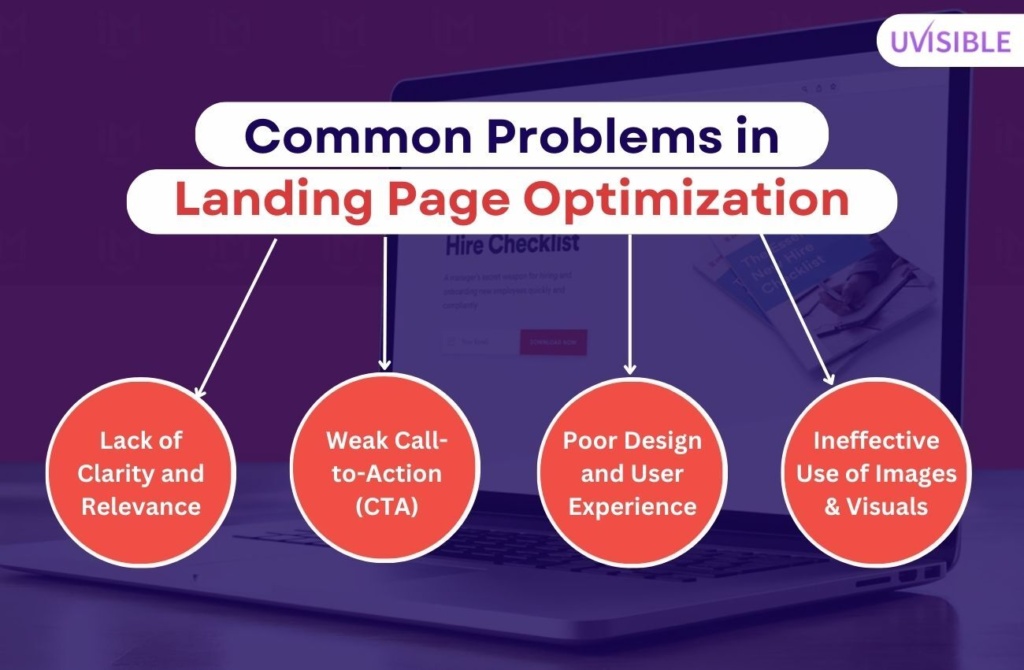
- Lack of Clarity and Relevance
One of the most common issues that hinder the effectiveness of landing page optimization is a lack of clarity and relevance.
Let’s explore two key issues:
- Inconsistent Messaging: Confusion comes when your landing page’s messaging doesn’t match the ad or link that led visitors there. Keeping the storyline constant will help visitors make the mental link between the click and the landing page. High bounce rates are often the result of inconsistent experiences that frustrate users.
- Irrelevant Content: Visitors will rapidly leave your landing page if its content doesn’t meet their expectations or fulfill their demands. It’s important to make the worth and relevancy of your service very obvious. Focus on the needs and interests of your niche to create content that truly resonates with them.
According to a study, 44% of clicks for B2B companies direct users to the homepage instead of a dedicated landing page, potentially causing confusion and a lack of relevance for visitors.
- Weak Call-to-Action (CTA)
A weak call-to-action can significantly hinder your landing page’s conversion potential.
Let’s explore two common issues:
- Unclear or Confusing CTAs: If your call-to-action is vague or lacks clarity, visitors may not understand what action they need to take. Your CTA should be explicit and specific, guiding visitors on the exact steps they should follow to fulfill the desired conversion goal.
- Lack of Urgency or Incentives: Without a sense of urgency or compelling incentives, visitors may feel no motivation to take immediate action. Incorporating urgency-inducing phrases or limited-time offers can create a sense of FOMO (fear of missing out) and encourage visitors to act promptly.
Reports state that landing pages with a single call-to-action button can increase conversion rates by 62%, emphasizing the importance of a clear and effective CTA.
- Poor Design and User Experience
The design and user experience of your landing page plays a vital role in its effectiveness.
Some of the common design-related problems are as follows:
- Slow Loading Speed: In today’s fast-paced digital world, visitors have little patience for slow-loading pages. If your landing page takes too long to load, visitors are likely to abandon it and move on to your competitors. Optimizing your page’s loading speed is crucial to retaining visitors and maximizing conversions.
- Complex Navigation: A landing page should have a simple and intuitive navigation structure. If visitors find it difficult to navigate or can’t easily find the information they need, they may become frustrated and leave. Streamline the navigation on your landing page to guide visitors smoothly toward the conversion goal.
According to Google, if your landing page takes more than three seconds to load, the probability of bounce increases by 30-40%.
Fed up with Poor Design and User Experience? Hire Uvisible – The Top Website Design and Development Agency!
- Insufficient Social Proof
Social proof plays a crucial role in building trust and credibility with your audience.
- Testimonials and Reviews: Including testimonials from satisfied customers or positive reviews can greatly influence visitors’ decision-making process. Genuine testimonials and reviews provide social proof, instilling confidence in your offering and demonstrating that others have had a positive experience.
Sharing real-life case studies or success stories showcases how your product or service has benefited previous customers.
These stories demonstrate the value you provide and help visitors envision themselves achieving similar results.
According to a Consumer Review Survey, 85-90% of consumers trust online reviews as much as personal recommendations, highlighting the significance of social proof in the purchasing process.
- Ineffective Use of Images and Visuals
Images and visuals can greatly impact the effectiveness of your landing page.
Let’s explore two common issues related to their use:
- Low-Quality Images: Using low-quality or pixelated images can create a negative impression of your brand and offering. High-resolution, professional images help convey a sense of credibility and professionalism.
- Irrelevant or Distracting Visuals: Visuals that are irrelevant to your offer or distract visitors from the main message can confuse or disengage them. Ensure that the visuals you choose align with your value proposition and enhance the overall user experience.
Imagine you’re designing a landing page for a luxury travel package.
Including high-quality images of picturesque destinations and happy travelers enjoying the experience can create an emotional connection and entice visitors to explore further.
By addressing these common problems in landing page optimization, you can improve the overall effectiveness and conversion potential of your landing pages.
Benefits of Landing Page Optimization
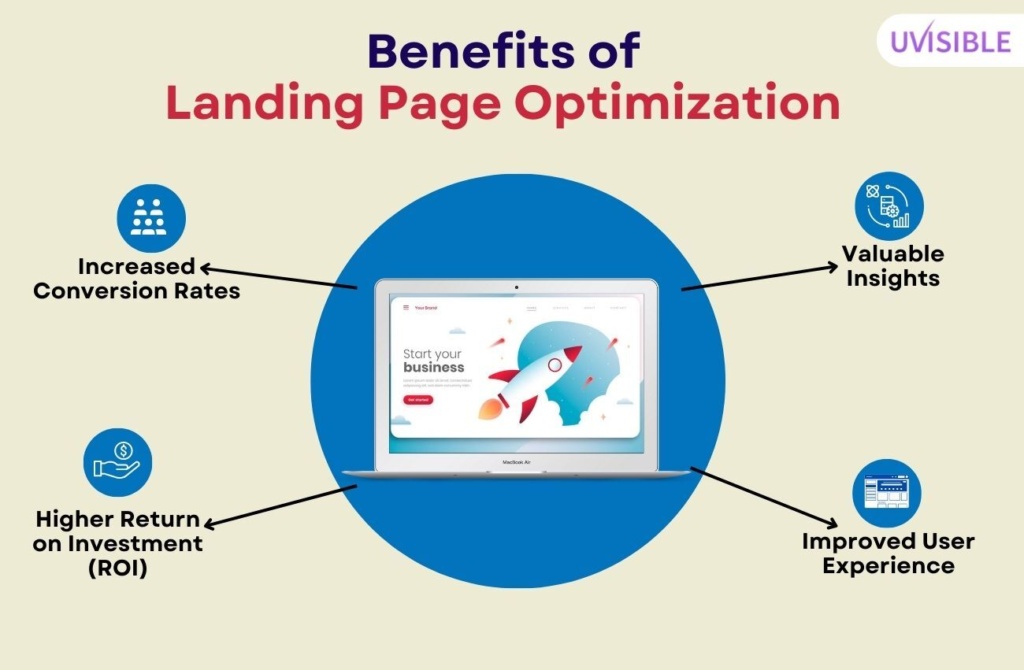
Increased Conversion Rates
The potential for enhanced conversion rates is one of the key advantages of landing page optimization.
You build an engaging user experience that promotes more conversions by fine-tuning your landing page components and aligning them with the requirements and expectations of your target audience.
Let us look into one of our eCommerce clients:
While performing SEO services for one of our eCommerce clients we initiated the optimized landing page strategy by simplifying the checkout process and improving the clarity of their value proposition.
As a result, their conversion rate increased by 20%, leading to a significant boost in sales.
Higher Return on Investment (ROI)
Landing page optimization has a direct impact on your return on investment.
By improving the conversion rate of your landing pages, you can make the most of your advertising budget and generate more revenue.
Consider another case:
As an experienced digital marketing agency, we have taken on a project with a primary focus on boosting our client’s ROI and discovering effective strategies on how to reduce bounce rate.
So again, we begin with optimizing their landing pages by implementing personalized content based on visitor demographics.
This resulted in a 15% increase in lead generation and a higher ROI on their marketing campaigns.
Improved User Experience
Optimizing your landing pages also enhances the overall user experience, which plays a vital role in driving conversions.
A seamless, user-friendly experience helps build trust and encourages visitors to take the desired action.
Here’s another leaf from our case studies section:
While working as a consultant for a software provider, we redesigned its landing page with a focus on mobile responsiveness and intuitive navigation.
As a result, their bounce rate decreased by 30%, indicating an improved user experience and increased engagement.
Enhanced Audience Targeting and Segmentation
Landing page optimization allows you to refine your targeting and segmentation strategies.
By tailoring landing pages to specific audience segments, you can deliver more personalized and relevant experiences, increasing the likelihood of conversions.
We vividly remember how we created a separate landing page for different customer segments based on an online fashion retailer’s utility, browsing history, and preferences.
This targeted approach led to a 25% increase in conversion rates among those segments.
Valuable Insights and Data Collection
Optimized landing pages also provide valuable insights and data collection opportunities.
By tracking user behavior and analyzing conversion rates, you can gather actionable data to refine your marketing strategies.
Let’s explore two key aspects:
- User Behavior Tracking: By implementing tools like heatmaps and user behavior tracking, you can gain insights into how visitors interact with your landing page. This data helps identify areas of improvement and informs future optimization efforts.
- Conversion Rate Analysis: Analyzing conversion rates provides valuable information about the effectiveness of your landing pages and the impact of optimization efforts. You can identify trends, test different elements, and make data-driven decisions to further optimize your conversions.
According to a study, companies that implement extensive conversion rate optimization strategies are more than twice as likely to see a large increase in sales.
For example, a known company that was a SaaS provider used user behavior tracking and A/B testing to optimize their landing page.
By analyzing the data and making iterative changes, they achieved a 40% increase in their overall conversion rate.
By embracing landing page optimization, businesses can benefit from increased conversion rates, higher ROI, improved user experience, enhanced audience targeting, and valuable insights for continuous improvement.
Landing Page Optimization Best Practices
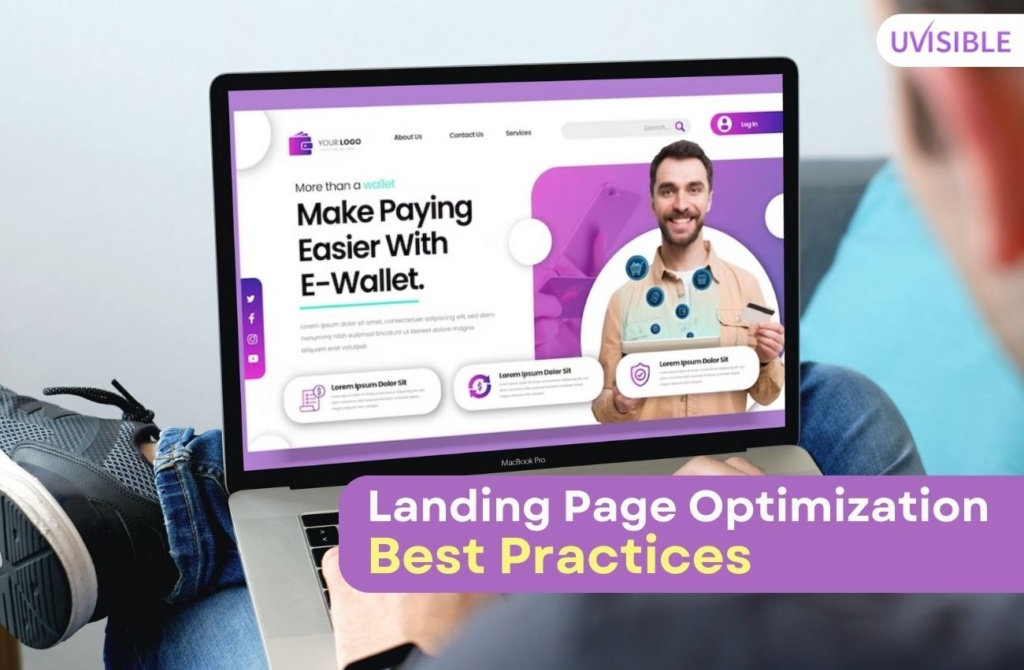
- Setting Clear Goals and Objectives
To kickstart your landing page optimization journey, it’s crucial to establish clear goals and objectives.
By defining what you want to achieve, you can align your optimization efforts and measure your success.
Here’s a best practice to follow:
SMART Goals (Specific, Measurable, Achievable, Relevant, Time-bound)
Set goals that are specific, measurable, achievable, relevant, and time-bound.
For example, rather than aiming to “increase conversions,” a SMART goal would be “increase landing page conversions by 15% within three months.”
- Conducting Audience Research and Segmentation
Understanding your target audience is key to optimizing your landing pages effectively.
By conducting audience research and segmentation, you can tailor your messaging and design to resonate with your ideal customers.
Consider the following best practices:
- Identifying Target Audience: Define your target audience based on demographics, psychographics, and behavioral factors. This helps you create personalized experiences that speak directly to their needs.
- Understanding User Intent and Pain Points: Dive deeper into your audience’s motivations, pain points, and desires. This knowledge allows you to craft compelling content that addresses their specific challenges and positions your solution as the answer.
- Crafting Compelling Headlines and Subheadings
The headline and subheadings on your landing page play a crucial role in capturing visitors’ attention and piquing their interest.
Implement these tactics:
- Using Attention-Grabbing Hooks: Craft headlines that instantly grab attention and make visitors want to learn more. Use strong, compelling words, pose thought-provoking questions, or highlight a unique benefit to captivate your audience.
- Incorporating Keywords and Benefits: Infuse relevant keywords into your headlines and subheadings to improve visibility in search results. Additionally, emphasize the key benefits of your offering to entice visitors to explore further.
You can write something like, “Revolutionize Your Productivity with Our Advanced Project Management Software – Get Started Today!”
- Creating a Strong Value Proposition
A strong value proposition communicates the unique value your product or service provides and why visitors should choose you over competitors.
Follow these best practices:
- Highlighting Unique Selling Points: Identify your unique selling points (USPs) that differentiate you from the competition. Communicate these USPs to demonstrate the value visitors can expect from engaging with your offering.
- Addressing Customer Needs and Desires: Understand the needs and desires of your target audience and align your value proposition accordingly. Articulate how your solution solves their pain points and fulfills their desires.
- Implementing Persuasive Copywriting Techniques
Compelling and persuasive copywriting can significantly impact the effectiveness of your landing page.
Follow these best practices to engage and persuade your audience:
- Using Clear and Concise Language: Write concisely and straightforwardly to ensure visitors can quickly grasp your message. Avoid jargon and complex language that may confuse or alienate your audience.
- Applying Emotional Appeals and Storytelling: Appeal to your audience’s emotions by incorporating storytelling techniques. Connect with their aspirations, fears, or desires, and paint a vivid picture of how your offering can transform their lives.
- Designing an Intuitive and Engaging Layout
The design and layout of your landing page greatly influence user experience and engagement.
Consider these best practices to create an intuitive and visually appealing design:
- Consistent Branding and Visual Identity: Maintain a consistent branding experience across your landing page. Use colors, fonts, and imagery that align with your brand identity to create a cohesive and memorable impression.
- Utilizing White Space and Visual Hierarchy: Utilize white space strategically to provide breathing room and draw attention to key elements. Establish a visual hierarchy that guides visitors’ attention toward important information and the call to action.
- Optimizing Forms and Conversion Elements
Forms and conversion elements are critical components of your landing page that directly impact conversions.
Optimize them using these best practices:
- Reducing Form Fields: Minimize the number of form fields to reduce friction and make the conversion process easier for visitors. Only ask for essential information that you need to fulfill their request.
- Providing Clear Instructions: Guide visitors on how to complete the form or take the desired action. Use concise and actionable instructions to eliminate confusion and improve the user experience.
- Implementing A/B Testing and Data Analysis
A/B testing and data analysis are essential for iterative improvements and data-driven decision-making.
Follow these best practices to optimize your landing pages effectively:
- Testing Different Page Elements: Conduct A/B tests to compare variations of different elements on your landing page, such as headlines, CTAs, colors, or layouts. Analyze the results to identify the winning variations that yield higher conversions.
- Analyzing Metrics and Conversion Rates: Regularly analyze metrics and conversion rates to gain insights into the performance of your landing pages. Identify trends, strengths, and areas for improvement to refine your optimization strategies.
- Ensuring Mobile Responsiveness
With mobile devices being widely used for online browsing, it’s crucial to optimize your landing pages for mobile responsiveness.
Consider these best practices:
- Responsive Design and Mobile Optimization: Ensure your landing page design is responsive, automatically adapting to different screen sizes and resolutions. Optimize images and fonts to ensure clarity and legibility on smaller screens.
- Touch-Friendly Buttons and Navigation: Design touch-friendly buttons and navigation elements that are easy to tap on mobile devices. Avoid elements that are too close together, making it challenging for users to interact accurately.
- Incorporating Trust Signals and Social Proof
Building trust is vital for successful conversions. Incorporate trust signals and social proof to instill confidence in your offering.
Follow these best practices:
- Trust Badges and Security Seals: Display trust badges and security seals, such as SSL certificates or payment gateway logos, to assure visitors of the safety and security of their information.
- Customer Testimonials and Reviews: Showcase customer testimonials and reviews to provide social proof and validate the quality and effectiveness of your product or service. Highlight positive experiences and outcomes from satisfied customers.
By following these landing page optimization best practices, you can create high-performing landing pages that engage visitors, drive conversions, and deliver optimal results.
Landing Page Optimization Tools
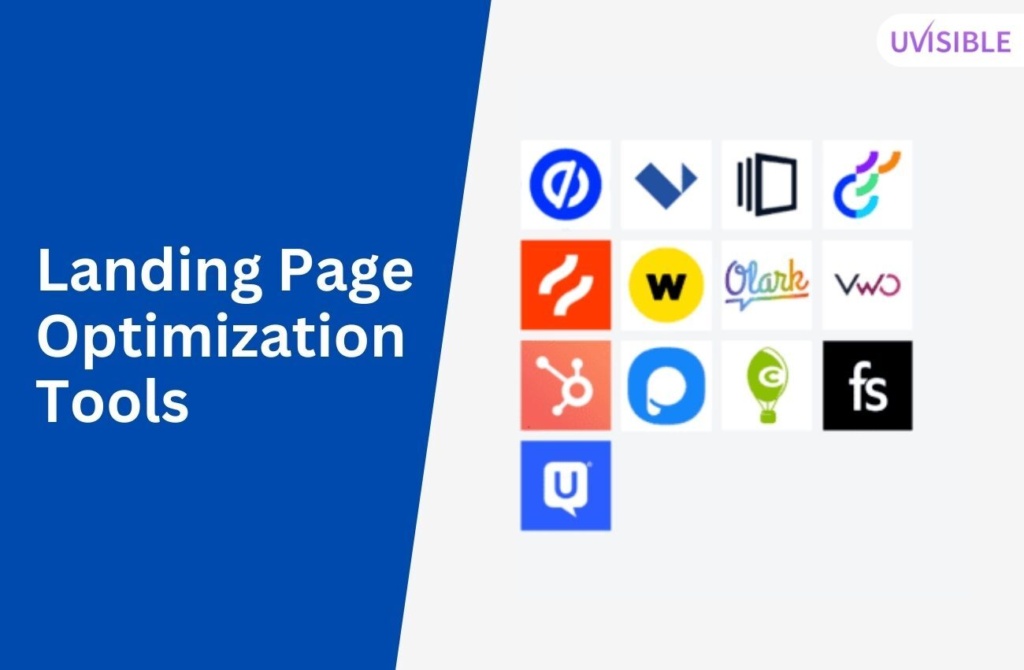
To optimize your landing pages effectively, you can leverage various tools specifically designed for landing page optimization.
These tools help you gather valuable data, conduct tests, and streamline your optimization process.
Let’s explore some of the essential tools:
- A/B Testing Tools
A/B testing allows you to compare different variations of your landing page elements to determine which ones perform better.
Here are two popular A/B testing tools:
- Optimizely: Optimizely is a versatile A/B testing tool that enables you to experiment with different variations of your landing page elements. It provides an intuitive interface and robust reporting features to help you measure the impact of your optimization efforts.
- Google Optimize: Google Optimize integrates seamlessly with Google Analytics and allows you to create and run A/B tests on your landing pages. It offers a user-friendly interface and detailed reports for analyzing the performance of your experiments.
- Heatmap and User Behavior Tracking Tools
Heatmap and user behavior tracking tools provide valuable insights into how visitors interact with your landing pages.
Consider these tools for understanding user behavior:
- Crazy Egg: It offers heatmaps, scroll maps, and click reports to visualize user behavior on your landing pages. These visual representations help you identify patterns, areas of interest, and potential areas for improvement.
- Hotjar: It combines heatmaps, visitor recordings, and feedback polls to provide a comprehensive view of user behavior. It enables you to understand how visitors navigate your landing pages and gather qualitative feedback from users.
- Form Optimization Tools
Forms are critical elements of your landing page, and form optimization tools can help improve their performance and conversion rates.
Consider these tools for optimized landing pages:
- Typeform: It offers a user-friendly form-building interface that allows you to create engaging and conversational forms. It provides customization options and features that enhance the user experience and encourage form completion.
- Wufoo: It is a flexible form builder that enables you to create and customize forms for your landing pages. It offers various form field options, advanced form logic, and integrations with popular third-party tools.
- Landing Page Builders and Templates
Landing page builders and templates simplify the process of creating and designing landing pages without the need for coding.
Consider these tools for building optimized landing pages:
- Unbounce: It is a popular landing page builder that provides a drag-and-drop interface and a wide range of customizable templates. It offers features like A/B testing, dynamic text replacement, and integration options to optimize your landing pages.
- Leadpages: This tool offers a user-friendly landing page builder with a library of mobile-responsive templates. It provides tools for A/B testing, lead capture, and integration with popular email marketing platforms.
- Analytics and Data Tracking Tools
Analytics and data tracking tools help you measure and analyze the performance of your landing pages.
Consider these tools for gathering valuable insights:
- Google Analytics: It is a powerful web analytics tool that provides detailed data on visitor behavior, traffic sources, and conversion rates. It helps you understand how your landing pages perform and make data-driven optimization decisions.
- Kissmetrics: It is an analytics tool that focuses on user behavior and customer insights. It allows you to track and analyze individual user actions, conversion funnels, and customer lifetime value to optimize your landing pages for maximum conversions.
These landing page optimization tools can streamline your optimization efforts, provide valuable data, and help you make data-driven decisions to improve the performance of your landing pages.
Supercharge Your Startup’s Online Success with Our SEO Agency for Startups!
Boost Your Visibility and Drive Organic Growth Today!
Troubleshooting: How to Optimize Landing Pages for Conversion
Despite your best efforts, sometimes landing pages fail to convert as expected.
Let’s explore common reasons why landing pages don’t convert and how to troubleshoot them effectively:
- Insufficient or Irrelevant Traffic
If your landing page isn’t receiving enough relevant traffic, conversions will naturally suffer. Consider these troubleshooting steps:
- Improving SEO and Keyword Targeting: Optimize your landing page for relevant keywords to improve its visibility in search engine results. Conduct keyword research, optimize meta tags, and ensure your content aligns with search intent.
- Enhancing Digital Advertising Campaigns: Review your digital advertising campaigns to ensure they are targeting the right audience and using relevant keywords. Optimize your ad copy, targeting settings, and landing page experience to attract qualified traffic.
- Confusing or Ineffective CTA
If your call-to-action (CTA) is unclear or doesn’t stand out, visitors may not know what action to take.
Follow these troubleshooting steps:
- Simplifying CTAs and Making Them Stand Out: Use clear, concise, and action-oriented language in your CTAs. Make them visually prominent with contrasting colors and positioning on the page to ensure they capture attention.
- Adding Urgency and Clear Instructions: Create a sense of urgency by using words like “limited time offer” or “act now.” Provide clear instructions on how to complete the desired action, guiding visitors through the conversion process.
- Weak Value Proposition
If your landing page fails to communicate a strong value proposition, visitors may not see compelling reasons to convert.
Troubleshoot this issue with the following steps:
- Reevaluating and Enhancing Unique Selling Points: Identify and emphasize the unique aspects of your product or service that differentiate it from competitors. Communicate the value and benefits visitors will gain by converting.
- Addressing Customer Needs and Desires: Understand your target audience’s pain points, desires, and motivations. Tailor your messaging to address these needs and demonstrate how your offering fulfills their specific requirements.
- Inconsistency between Ad and Landing Page
If there is a disconnect between the messaging and visuals of your ad and landing page, visitors may feel confused or misled.
Troubleshoot this issue with the following steps:
- Aligning Messaging and Visuals: Ensure that the headline, key message, and visuals on your landing page align with the ad or link that brought visitors there. Maintain a consistent narrative and visual continuity to avoid confusion.
- Ensuring Ad-Landing Page Relevance: Review your ad copy and landing page content to ensure they are relevant to each other. Visitors should feel a seamless transition from the ad to the landing page, with the content reinforcing their expectations.
By troubleshooting these common issues and implementing the necessary improvements, you can increase the conversion rate of your landing pages and drive better results.
Measuring Success: What is a Good Conversion Rate for Landing Pages?
- Understanding Conversion Rate
The conversion rate is a key metric that measures the percentage of visitors who take the desired action on your landing page.
Let’s explore the concept further:
Conversion Rate = (Number of Conversions / Number of Visitors) * 100
- Industry Benchmarks for Conversion Rates
Conversion rates vary across industries and can be influenced by various factors. While there is no universal benchmark for a “good” conversion rate, understanding industry averages can provide a point of reference.
Here are some examples:
- Ecommerce: The average conversion rate for e-commerce websites is around 2% to 3%. However, top-performing e-commerce businesses can achieve conversion rates of 10% or higher.
- B2B (Business-to-Business): B2B conversion rates typically range from 2% to 5%. However, complex sales cycles and high-value transactions may result in lower conversion rates.
- SaaS (Software-as-a-Service): SaaS companies often have conversion rates between 3% and 8%. However, it’s important to note that the complexity of the product and the target audience can significantly impact conversion rates.
ALSO READ: SEO for Ecommerce Product Pages
- Factors Affecting Landing Page Conversion Optimization
Several factors can influence conversion rates.
Understanding these factors helps you contextualize your conversion rate performance.
Let’s explore two key factors:
- Industry and Competition: Conversion rates can vary based on the industry you operate in and the level of competition. Highly competitive industries may experience lower conversion rates due to increased options and more demanding customers.
- Target Audience and Product/Service: The characteristics of your target audience and the nature of your product or service play a significant role in determining conversion rates. For example, niche products/services targeting a specific audience may achieve higher conversion rates compared to mass-market offerings.
- Strategies for Improving Conversion Rates
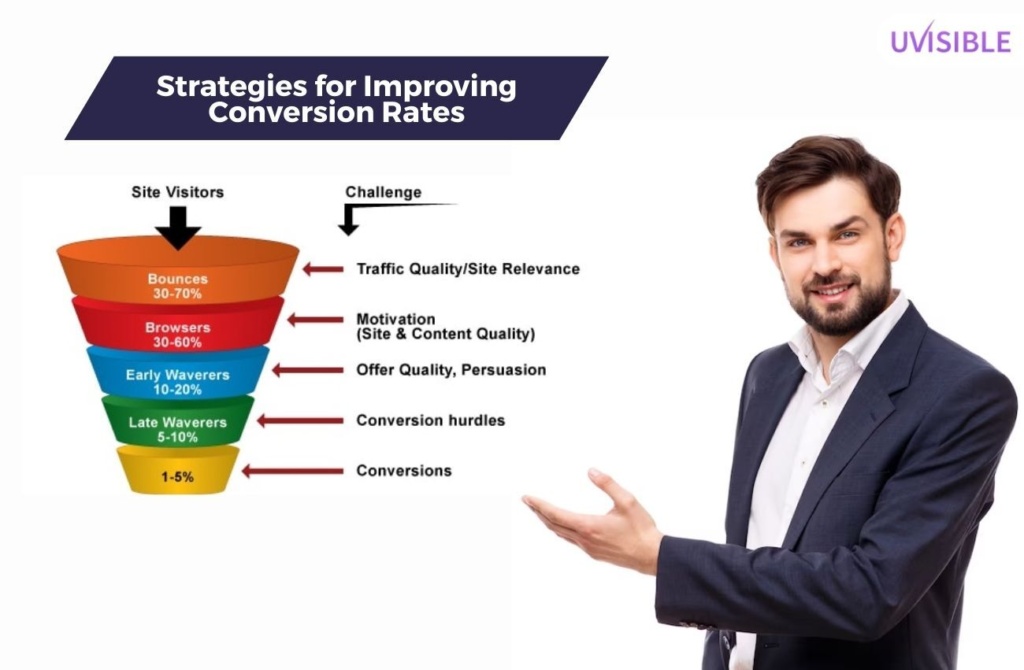
While the concept of a “good” conversion rate is relative, there are strategies you can implement to continuously improve your conversion rates.
Consider the following:
- Continuous Testing and Optimization: Implement a robust testing and optimization process to identify areas of improvement. Conduct A/B tests, analyze data, and iterate on your landing page elements to enhance conversion rates over time.
- Personalization and Customization: Tailor your landing pages to match the specific needs and preferences of your target audience. Leverage personalization techniques, such as dynamic content and targeted messaging, to create a more relevant and engaging experience.
According to a study, the top 25% of advertisers achieve a conversion rate of 5.31% or higher, highlighting the impact of optimization efforts on improving conversion rates.
By consistently testing, optimizing, and personalizing your landing pages, you can improve your conversion rates and drive more successful outcomes for your business.
Conclusion
Throughout this comprehensive landing page optimization checklist, we’ve covered various aspects to help you understand and implement effective landing page optimization tips and strategies.
Let’s recap the key points:
- Landing page optimization involves improving your landing pages to maximize conversions and achieve your goals.
- Common problems include lack of clarity, weak CTAs, poor design, insufficient social proof, and ineffective use of visuals.
- The benefits of landing page optimization include increased conversion rates, higher ROI, improved user experience, enhanced targeting, and valuable data insights.
- Best practices involve setting clear goals, conducting audience research, crafting compelling content, optimizing design and forms, A/B testing, and ensuring mobile responsiveness.
- Tools like A/B testing platforms, heatmap trackers, form optimization tools, landing page builders, and analytics solutions can streamline the optimization process.
Now that you have a comprehensive understanding of landing page optimization best practices, it’s time to take action. Implementing these strategies can lead to significant improvements in your conversion rates, ROI, and overall business success.
Don’t miss out on the opportunity to optimize your landing pages and create engaging experiences for your visitors.
Looking to boost your marketing campaign through landing page optimization?
Hire Uvisible NOW!
We are the Best PPC Company in India, known for refining key elements and creating a user-friendly experience!
About us and this blog
We are a digital marketing company with a focus on helping our customers achieve great results across several key areas.
Request a free quote
We offer professional SEO services that help websites increase their organic search score drastically in order to compete for the highest rankings even when it comes to highly competitive keywords.
Subscribe to our newsletter!
More from our blog
See all postsRecent Posts
- 10 Holiday Marketing Tips: Boost Sales & Engagement December 21, 2024
- 10 Common Mistakes Roofing PPC Companies Should Avoid December 19, 2024
- Landing Page Copy That Converts – Secrets Revealed December 16, 2024









Pingback: How To Write A Landing Page Copy: Tips That Will Convert